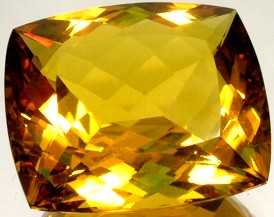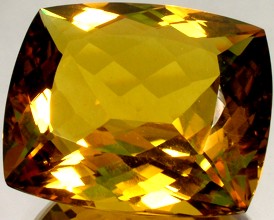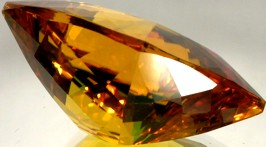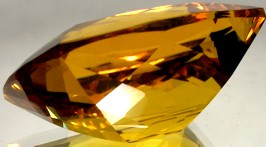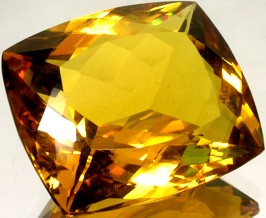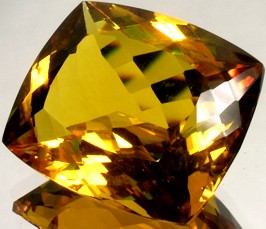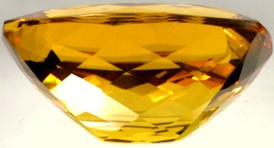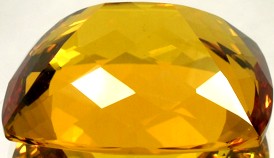|
For Customers outside of USA 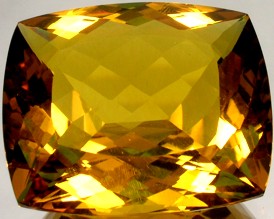
COLOSSAL Antique Nineteenth Century Eighty-Three and One-Quarter Carat Genuine Natural Faceted "Old-Fashioned" Cut Amber-Orange Citrine. ORIGIN: Coastal Devonian Lava Beds, Angus, Scotland. 19th Century. SIZE: Length: 31 3/4mm. Width: 27mm. Depth: 15 1/4mm. All measurements approximate. WEIGHT: 83.18 carats. NOTES: Upon request we can set your gemstones as a ring, pendant, or as earrings (click here for more information).
DETAIL: The ancient Romans, Greeks and Celts all believed citrine to be the crystallized essence of sunshine, and believed it would aid in digestion and cleanse toxins from the body, and it was even carried as protection against snake venom. Here's an enormous, very clean, 19th century amber orange or bright cognac colored citrine which originated from the Devonian lava beds found along the coast of Angus Country, Scotland. Very popular in 18th and 19th century Victorian Scotland, citrine has remained a very popular gemstone through the 20th century.
The gemstone was hand crafted and faceted by a 19th century Russian artisan, part of an heritage renown for the production of the elaborate gemstones and jewelry of the Czars of Medieval, Renaissance, and Victorian Russia. The gemstone was crafted into a sparkling faceted "old-fashioned" cut (also known within the trade as a "cushion cut"). This is a very fine, beautifully hued orange-amber, or "bright cognac" colored semi-precious citrine gemstone. As you can see from the photo enlargements here, possesses exceptional sparkle and luster, and to the unaided eye at least, free from blemishes. It is very clean, water clear, and very bright.
Under magnification the gemstone shows the unmistakable characteristics of having been hand crafted. The coarseness of the 19th century finish is considered appealing to most gemstone collectors, and is not considered a detriment, or detract from the value of a gemstone. These characteristics are not only expected of hand-finished gemstones, most serious collectors consider such gemstones more desirable, possessed of greater character and uniqueness when compared to today's cookie-cutter mass-produced machine-faceted gemstones. Unlike today's computer controlled machine produced gemstones, the cut and finish of a gemstone such as this is the legacy of an artisan who lived two centuries ago.
This gemstone possesses superb luster and sparkle, and to the eye is completely transparent, but one cannot say with absolute certainty that it is unconditionally flawless. True, the blemishes it possesses are not visible to the naked eye, and the gemstone can be characterized at a minimum, to use trade jargon, as "eye clean", it even approaches "loupe clean". To the eye it is indeed flawless; however magnified 600%, as it is here, you might be able to just barely pick out one or two slight imperfections within the gemstone, barely perceptible even at such high magnification. Of course the same may said about almost any natural gemstone. An absolutely flawless gemstone simply is not the rule in nature. Most absolutely flawless gemstones will upon close examination be revealed to be synthetic. You might also notice under magnification occasional irregularities in the cut and finish.
Naturally these characteristics are not only expected of hand-finished gemstones, you must also consider that two centuries ago the mining techniques prevalent did not allow the ultra deep mining operations which are so common today. Keep in mind that two centuries ago mankind was more or less limited to surface deposits or near surface deposits of gemstones. Higher quality gemstones which today are routinely mined from beneath hundreds of meters, even kilometers beneath the earth's surface, were simply inaccessible then. For these reasons antique gemstones must be appreciated as antiques first, gemstones second. The relatively superlative quality of contemporary gemstones routinely mined from deep beneath the earth's surface today were simply not accessible two centuries ago, or at least, only rarely so. However for most, the unique nature and character of antique gemstones such as this more than makes up for minor blemishes both within the gemstone, as well as in the cut and finish, which by and large, are (if at all) only visible under high magnification.
HISTORY: Citrine, like Amethyst, is part of the quartz family. Citrine takes its name from the Latin "citrus" for citrus tree. Natural citrine is actually somewhat rare in nature. Most citrines on the market today have been converted from less expensive amethyst or smoky quartz through a heat process. True citrine is characterized by light yellow tones, as opposed to the orange/violet tones of "converted" citrine. Citrine is widely used in jewelry due to its availability, affordability, and durability. It was popular in the late Victorian era and was often set with other semiprecious stones such as bloodstones, carnelian and garnets. The Greeks and Romans used Citrine for intaglios and as cabochon (polished) gemstones during the first and second centuries. The gemstone was worn as a protective talisman and used for medicinal purposes. The Romans and Greeks believed it to be the crystallized essence of sunshine, and believed it would aid in digestion and cleanse toxins from the body. Citrine was carried as protection against snake venom.
SHIPPING OPTIONS: All purchases are backed by an unlimited guarantee of satisfaction and authenticity. If for any reason you are not entirely satisfied with your purchase, you may return it for a complete and immediate refund of your entire purchase price. Most of these antique gemstones were originally part of two collections, one originating in India principally composed of gemstones originally mined in India, Burma, Ceylon, and Siam, and then hand faceted in India. The addition of a second accumulation of antique gemstones originally mined in the Urals in the mid to late 19th century (including alexandrite) completed the collection. These gemstones as well were hand finished. The Urals have been one of the world's major sources of precious and semi-precious gemstones for many centuries. As well, additional specimens are occasionally acquired from other institutions and dealers in Eastern Europe and Asia. These antique gemstones are now in the United States and are available for immediate delivery. We ship inventory from the USA order fulfillment center near Seattle, Washington. Your purchase will ordinarily be shipping within 48 hours of payment. A certificate of authenticity is available upon request. We prefer your personal check or money order over any other form of payment - and we will ship immediately upon receipt of your check (no "holds"). We will accept PayPal payments. Please see our "ADDITIONAL TERMS OF SALE".
|
|---|
